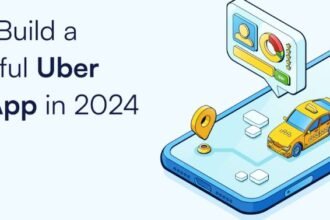In today’s fast-paced world, ride-hailing apps like Uber have revolutionized how we commute. Creating an Uber clone app can be lucrative, given the demand for convenient transportation solutions. But how do you develop a successful Uber clone app? Let’s dive into the top tips and strategies to ensure your app stands out in the crowded marketplace.
Understanding the Market
Market Research
Thorough market research is crucial before diving into development. Understand the current market trends, user preferences, and technological advancements. This helps identify gaps that your app can fill.
Target Audience
Defining your target audience is vital. Are you catering to city dwellers, suburban families, or international travelers? Knowing your audience helps tailor the app’s features and marketing strategies.
Competitor Analysis
Study your competitors. What are they doing right? Where are they lacking? Learning from their strengths and weaknesses can give you a competitive edge.
Essential Features of a Successful Uber Clone App
User-Friendly Interface
A clean, intuitive interface is critical. Users should be able to book a ride with minimal effort, and the design should be simple yet engaging.
Real-Time Tracking
Real-time tracking is a must-have feature. It enhances the user experience by providing live updates on the driver’s location and estimated arrival time.
Multiple Payment Options
Offering various payment methods, including credit/debit cards, digital wallets, and cash, ensures convenience and user satisfaction.
Driver and User Profiles
Detailed profiles for both drivers and users help in building trust. Include features like profile photos, ride history, and preferences.
Rating and Review System
A robust rating and review system ensures accountability and encourages better service quality from drivers.
Ride Scheduling
Allow users to schedule rides in advance. This feature adds a layer of convenience for users planning their travel ahead of time.
Technology Stack for Uber Clone App Development
Frontend Technologies
Choose the right frontend technologies like React Native or Flutter for a seamless user experience across different platforms.
Backend Technologies
For backend, technologies like Node.js or Ruby on Rails ensure robust performance and scalability.
Database Options
Opt for reliable databases such as MongoDB or PostgreSQL to handle large volumes of data efficiently.
APIs and Integrations
Integrate essential APIs for functionalities like maps, payment gateways, and notifications.
Design and User Experience
Importance of Design
Design is more than aesthetics; it’s about usability. A well-designed app can significantly enhance user satisfaction and retention.
UI/UX Best Practices
Follow UI/UX best practices to create an engaging and easy-to-navigate app. Pay attention to color schemes, typography, and button placements.
Prototyping and User Testing
Create prototypes and conduct user testing to gather feedback. Iterative testing helps in refining the design before the final launch.
Development Process
Planning and Strategy
Start with a solid plan. Define your goals, milestones, and deliverables. A clear strategy guides the development process.
Development Phases
Break the development into manageable phases: ideation, design, development, testing, and deployment. This structured approach ensures a smoother workflow.
Agile Methodology
Adopt agile methodology for flexibility and iterative improvements. Regular sprints and reviews keep the project on track and responsive to changes.
Security and Compliance
Data Security
Ensure data security with encryption and secure authentication protocols. Protecting user data is paramount.
Compliance with Regulations
Adhere to local and international regulations regarding data privacy and security. This helps in avoiding legal issues and building user trust.
Privacy Policies
Draft clear and transparent privacy policies. Inform users about how their data is collected, used, and protected.
Monetization Strategies
Ride Fare
Earning from ride fares is the primary revenue model. Ensure competitive pricing to attract and retain users.
Subscription Models
Offer subscription plans for frequent users. This provides a steady income stream and enhances user loyalty.
Advertising
Incorporate advertising carefully to avoid disrupting the user experience. Partner with relevant brands for in-app ads.
Testing and Quality Assurance
Importance of QA
Quality assurance is crucial for a bug-free app. It ensures all features work seamlessly across different devices and platforms.
Testing Phases
Conduct various testing phases, including unit testing, integration testing, and user acceptance testing, to identify and fix issues.
Bug Fixing and Updates
Post-launch, promptly address bugs and release updates. Regular maintenance keeps the app running smoothly and securely.
Launch and Marketing
Pre-Launch Strategies
Create a buzz before the launch. Use social media, press releases, and beta testing to generate interest and gather feedback.
Launch Day Activities
Ensure everything is set for the launch day. Monitor the app’s performance and be ready to address any issues.
Post-Launch Marketing
Continue marketing efforts post-launch. Use social media, influencer partnerships, and user reviews to maintain momentum and attract new users.
Post-Launch Support and Maintenance
Regular Updates
Regularly update the app with new features and improvements. This keeps the app relevant and engaging.
Customer Support
Provide excellent customer support. Address user queries and issues promptly to ensure a positive experience.
Handling Feedback
Listen to user feedback and incorporate suggestions. This helps in continuously improving the app.
Case Studies of Successful Uber Clone Apps
Example 1
Analyze a successful Uber clone app and identify key factors contributing to its success.
Example 2
Study another successful app to gather more insights and best practices.
Common Challenges and Solutions
Challenge 1
Discuss a common challenge faced during Uber clone app development and provide a solution.
Challenge 2
Highlight another challenge and its solution to prepare developers for potential hurdles.
Future Trends in Uber Clone App Development
AI and Machine Learning
Explore how AI and machine learning can enhance ride-hailing apps with features like predictive analytics and personalized recommendations.
Autonomous Vehicles
Discuss the potential impact of autonomous vehicles on the ride-hailing industry and how to prepare for this trend.
Sustainability
Highlight the growing importance of sustainability and eco-friendly practices in app development.
Conclusion
Summarize the main points discussed in the article, emphasizing the importance of each step in developing a successful Uber clone app. Encourage readers to take a strategic and user-centric approach to app development for long-term success.
FAQs
How long does it take to develop an Uber clone app?
The development time varies based on the app’s complexity, features, and team expertise. On average, it can take 4-6 months.
What is the cost of developing an Uber clone app?
The cost depends on various factors such as features, technology stack, and development team’s location. It can range from $20,000 to $100,000 or more.
Can I customize my Uber clone app?
Yes, most Uber clone apps are customizable. You can tailor features, design, and functionalities to suit





